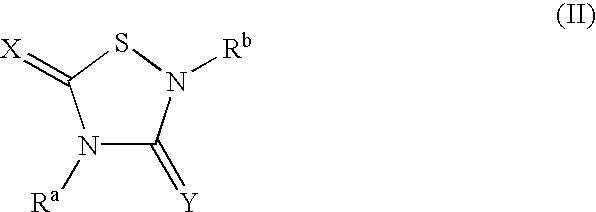Heterocyclic inhibitors of glycogen synthase kinase GSK-3
a glycogen synthase and heterocyclic inhibitor technology, applied in the field of enzyme inhibitors, can solve the problems of dementia in the elderly population, and the activity of these kinases has not been found to be upregulated
- Summary
- Abstract
- Description
- Claims
- Application Information
AI Technical Summary
Benefits of technology
Problems solved by technology
Method used
Image
Examples
example 1
Enzymatic Inhibition of the Compounds of the Invention
GSK-3β inhibition: The GSK-3 activity was determined by incubation of a mixture of GSK-3 enzyme (Sigma), a phosphate source and a GSK-3 substrate in the presence and in the absence of the corresponding test compound, and by measuring the GSK-3 activity of this mixture.
Concretely, the GSK-3 activity is determined by incubating the enzyme at 37° C. during 20 minutes in a final volume of 12 μl of buffer (50 mM tris, pH=7.5, 1 mM EDTA, 1 mM EGTA, 1 mM DTT, 10 mM Cl2Mg) supplemented with 15 μM (final concentration) of the synthetic peptide GS 1 [Woodgett, J. R. “Use of peptides for affinity purification of protein-serine kinases”, Anal. Biochem., 1989, 180, 237-241] as substrate, 15 μM of ATP, 0.2 μCi of [γ-32P]ATP and different concentrations of the test compound. The reaction is quenched by addition of an aliquot of the reaction mixture in phosphocelullose p81 papers. These papers are washed three times with phosphoric acid 1% and t...
example 2
Analysis of the Neurites Growth After the Drug Treatment
Cells were maintained in a Dulbecco medium (DEMEM) with a 10% fethal bovine serum, glutamine (2 mM) and antibiotics. For the analysis of the potential GSK-3 inhibition in vivo, mice neuroblastoms N2A cultures (Garcia-Perez, J.; Avila, J.; Diaz-Nido, J. “Lithium induces morphological differentiation of mouse neuroblastoma”, J. Neurol. Res., 1999, 57, 261-270) were used. The test compounds were added to these cells cultures. This cell line has the particularity of expressed a certain kind of neuronal phenotype (neuritic extensions) after the addition of lithium chloride (10 mM), a known GSK-3 inhibitor. After 2-3 days of culture, it was check the effect of the tested compounds gathered in table I. It was observed that the generation of neuritic extension in the same extension than when lithium was added. That fact confirms the in vivo GSK-3 inhibition of the compounds of the invention.
example 3
In parallel, the potential interference of these compounds with the cell cycle was studied on N2A cells. The cell culture was maintained in a Dulbecco medium (DEMEM) with a 10% fethal bovine serum, glutamine (2 mM) and antibiotics.
The first four compounds of general formula (I) gathered in Table 3 were assayed in the described conditions and shown ability to inhibit the cell cycle at an inhibitor concentration comprised between 100 nM and 1 μM. The cellular blockade was initially observed at concentrations comprised between 100-200 nM and was totally effective at 1 μM.
The tested compounds was non toxic in stationary fibroblast culture MRC-5 after 10 days of continue exposure to the inhibitors.
PUM
| Property | Measurement | Unit |
|---|---|---|
| composition | aaaaa | aaaaa |
| stability | aaaaa | aaaaa |
Abstract
Description
Claims
Application Information
 Login to View More
Login to View More - R&D
- Intellectual Property
- Life Sciences
- Materials
- Tech Scout
- Unparalleled Data Quality
- Higher Quality Content
- 60% Fewer Hallucinations
Browse by: Latest US Patents, China's latest patents, Technical Efficacy Thesaurus, Application Domain, Technology Topic, Popular Technical Reports.
© 2025 PatSnap. All rights reserved.Legal|Privacy policy|Modern Slavery Act Transparency Statement|Sitemap|About US| Contact US: help@patsnap.com



